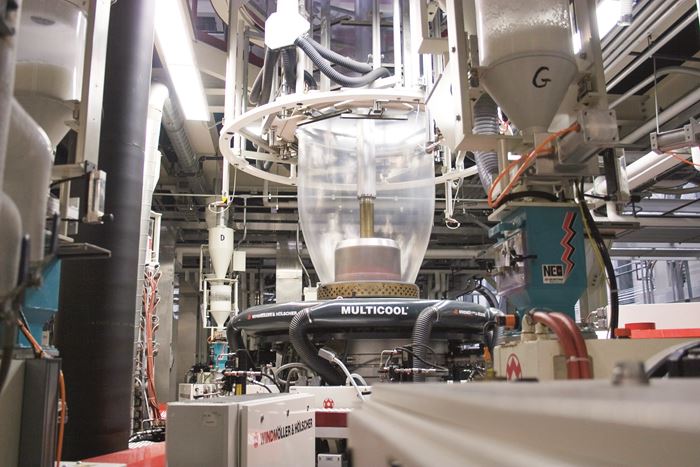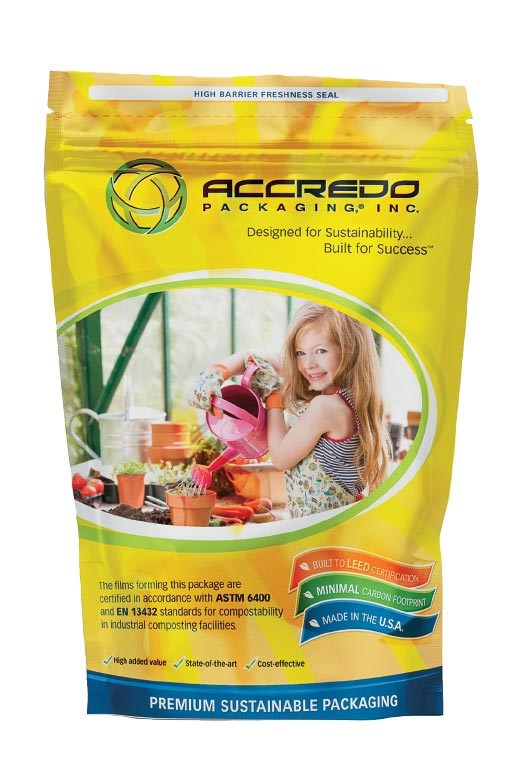In fewer than 10 years, Accredo Packaging has become a force in sophisticated films for high-end packaging, fueled by a business strategy whose structure from the time it filled its first order in June 2009 has been built on a foundation of innovation, integration, and sustainability. With sales increasing at a clip of a 20% a year, the company has already outgrown its 350,000 ft2 plant in Sugar Land, Tex., and is building an additional 200,000 ft2 plant on its 32-acre campus that it expects to occupy next year. When all is said and done, the flexible packaging producer expects to employ more than 500 people in a 24:7 operation that combines high-end film processing—every structure is multi-layer, with capabilities up to 9-layer—with sophisticated printing, laminating, bag- and pouch-making technologies.
The Accredo model is patterned after its sister company, Advanced Polybag Inc. (API), which for more than 30 years has been making grocery sacks in four plants in the U.S. and one in Thailand. Whereas most commodity film processors that venture into high-end packaging take the acquisition route, Accredo was started from the ground up. States Rex Varn, the firm’s executive v.p., “The ownership diversified into the high-end packaging business because it saw growth in the grocery-sack market had leveled out. The idea was to get into producing high-valued products.”
The affiliation of API and Accredo gave the latter a degree of buying power that start-ups don’t normally enjoy. States Varn, “We don’t buy the same materials as API but purchase from the same resin suppliers. That gave us some purchasing power. Instead of being an unknown entity, we came in with purchasing leverage not only for resin but for equipment too.”
The company’s North American production facility has multiple blown-film extrusion lines from Windmoeller & Hoelscher Corp., Lincoln, R.I., with technology to produce three-, five-, and nine-layer structures. In short order, Accredo will commission a new W&H blown film line that will be equipped with machine-direction orientation technology.
This technology will enable Accredo to produce lightweight, “breathable” films down to 11g/m2 for applications that include diapers and feminine-hygiene products, as well as medical drapes and gowns.
In the last year, Accredo North America also added two new 10-color W&H Flexographic printing presses, with another W&H press scheduled to arrive by early first-quarter 2019. In addition, it recently installed a three-layer tandem laminator with registered over-varnish capability.
Much of Accredo’s product offerings consist of barrier films for gas-flushing and vacuum-packaging applications that can be utilized on both vertical and horizontal form-fill-seal machines. The firm also produces roll stock and stand-up pouches that can be furnished on a turnkey basis with sliders, zippers, spouts, and a hook & loop reclosure. Accredo’s product lines also include towel and tissue overwrap, collation shrink film, wicketed bags, and biobased films. Films are produced in thicknesses from less than 1 mil up to 10 mil. The firm processes PEs of various types, along with renewable PE, PP, nylon, EVOH. “We run Braskem’s ‘green PE’ based on sugarcane feedstock,” notes Malcolm Cohn, Accredo’s director of sustainability. “We’re seeing a lot of growth for these films in sealant webs and for towel and tissue overwrap.” At press time, according to Cohn, a national brand was testing film made completely of the renewable PE for towel and tissue film. Accredo believes it’s the first film extruder to run this material.
Accredo officials were reluctant to disclose the size of the company—either in terms of sales, volume of resin consumed, or precise number of processing lines. It did acknowledge that the expansion will enable the company to boost annual production of flexible film from 1.5 billion ft to 2 billion ft. “We’re not small, and while we may sometimes compete against billion-dollar businesses, we don’t consider ourselves large by any stretch of the imagination,” Varn says. “However, we have tools at our disposal—including a million-dollar-plus lab—that companies of our size wouldn’t normally have. Since we’re family owned, we react quickly. We can walk down the hall and talk to the owner and get an answer after a meeting. Decisions are made quickly. Our owners are quick to say yes or no, and if it’s yes, we’re ordering the equipment tomorrow.”
States David Bertelsman, Accredo’s director of R&D & Technology, “Being fast and nimble is critical to us. As a custom flexible packaging manufacturer, it’s vital that we understand the packaging needs of our customers and respond to those needs quickly. Our mission is to develop films that add value to customers. The tools in our lab allow us to analyze competitive structures so that we understand their characteristics and how they are performing.”
He adds, “We can analyze film through microscopy, barrier analysis, and field characterization. We have DSC and FTIR capabilities. The tools support both our own quality control and production as well as R&D. And we have results in hours, as opposed to the weeks it would take if we were to send film samples to outside labs.”
Adds Varn, “Sometimes customers come to us for a product having similar characteristics to what they are already using. We can certainly come up with that ‘me too’ product, but over time we’ll work with them to develop a lower-cost or more sustainable option. Our sustainability story is a very strong point of differentiation between us and our competitors.”
THE SUSTAINBILITY STORY
Accredo demonstrates its commitment to green in several ways, says Cohn. “We’ve integrated sustainability into every aspect of Accredo’s business model,” he says. “As one of our core values, sustainability is critical in the products we create, their impact upon the environment, our worker-safety initiatives and our environmental policies.”
Accredo utilizes 100% wind-generated electrical power and is said to be the first flexible packaging plant in the U.S. to be granted LEED (Leadership in Energy and Environmental Design) Silver certification under the U.S. Green Building Council (USGBC) rating system. LEED promotes sustainable site development and material selection, water conservation, energy efficiency, and indoor environmental quality. The company is also BRC (British Retail Consortium) certified (“AA” Rating), a global standard for food safety established in 1998.
Accredo also offers four sustainable packaging options, Cohn elaborates. Its “conventional” sustainable option product offerings are so named because they provide high-barrier films sourced from conventional hydrocarbon-based raw materials but produced in a more sustainable production process. Cohn states, “We’ve revolutionized the packaging industry by developing a proprietary printing process that brings new meaning to the term ‘expanded color gamut.’ Accredo’s state-of-the- art printing process can reproduce a world of limitless colors and is so finely tuned that we can guarantee a consistent visual match from job to job, whether hours or months apart. Driven by an innovative ink-delivery system, we eliminate all ink changes (resulting in up to 95% less ink waste and significant reduction in solvent usage) and high-speed setup between jobs.”
Its recyclable option is perhaps best illustrated by Accredo’s 2015 collaboration with the Dow Chemical Company, Midland, Mich., and the Sustainable Packaging Coalition (SPC). That effort resulted in the development of all-PE, fully recyclable barrier film for pouches that can potentially replace co-mingled, multi-material structures (e.g. PET/LDPE), which are primarily landfilled. The product is made with Dow’s Retain modifiers. Dow says it’s the first package of its kind with barrier film that can be recycled in a PE recycling stream.
Accredo can supply film—trademarked AccredoFlex RP (recyclable pouch)—in up to 18 layers by laminating two nine-layer structures. Varn recalls, “We worked with the recycling community to make sure the product met their requirements. This was a long-term project and took a year to qualify. We were the first to develop a film product that is both recyclable and has gas-barrier properties. The moisture barrier is improved as well.”
There’s a lot of “secret sauce” that went into making this possible. Notes Bertelsman, “Sophisticated raw-materials technology and high-tech machinery combined with processing know-how allowed us to put structures together to create barrier performance and recyclability along with all the other functional performance that these films must have to be successful.” The pouch was created for Seventh Generation, Burlington, Vt., making it the first laminated recyclable package for dishwasher pods.
Its renewable option, including Accredo’s previously noted work with Braskem, is third-party certified in accordance with ASTM D6866. The material can be run on existing equipment without compromising line speeds.
Accredo is said to be the first company in the world to manufacture a zippered standup pouch made from components certified compostable in accordance with ASTM 6400 standards for compostability in industrial composting facilities. Cohn says new developments in compostable film technology enable Accredo to produce compostable packaging with high moisture and gas barriers.
AHEAD OF THE CURVE
At the outset, Accredo will use its new plant for warehousing. But it was built, according to Varn, “in preparation for and anticipation of continued growth.” He explains, “Ownership likes to be ahead of requirements, and basically we need more capacity. The building has a raised roof to accommodate installation of additional blown film extrusion lines. Like the original plant, this facility will be equipped with a rail line. Material is fed by railcars to indoor silos, which convey resin to multi-component gravimetric blenders. Depending on the order size, lines can run for a few hours to days on end.
“Accredo has grown significantly since its founding in 2009,” says Varn. “We attribute our continuing success to our company owner’s investment in leading-edge technologies, including high-tech plant operations, a dedicated workforce, and exceptional customer service,” adds Varn.
Concerning future growth, Varn observes: “The further downstream the product goes, the more assets it touches during manufacturing. In the case of pouches, for example, we do it all. And there is lots of ongoing conversion to standup pouches from boxes, cans, jars, etc. We feel we have a leadership position there, as well as in shrink-bundling films and towel/tissue-wrap films.”
Related Content
Impacts of Auto’s Switch to Sustainability
Of all the trends you can see at NPE2024, this one is BIG. Not only is the auto industry transitioning to electrification but there are concerted efforts to modify the materials used, especially polymers, for interior applications.
Read MoreGet Color Changes Right In Extrusion Blow Molding
Follow these best practices to minimize loss of time, material and labor during color changes in molding containers from bottles to jerrycans. The authors explore what this means for each step of the process, from raw-material infeed to handling and reprocessing tails and trim.
Read MoreLatest Data on Bottled Water Shows Continued Strong Growth
Bottled water’s volume surpassed soft drinks for the first time in 2016 and has done so every year since.
Read More‘Monomaterial’ Trend in Packaging and Beyond Will Only Thrive
In terms of sustainability measures, monomaterial structures are already making good headway and will evolve even further.
Read MoreRead Next
Beyond Prototypes: 8 Ways the Plastics Industry Is Using 3D Printing
Plastics processors are finding applications for 3D printing around the plant and across the supply chain. Here are 8 examples to look for at NPE2024.
Read MoreLead the Conversation, Change the Conversation
Coverage of single-use plastics can be both misleading and demoralizing. Here are 10 tips for changing the perception of the plastics industry at your company and in your community.
Read MorePeople 4.0 – How to Get Buy-In from Your Staff for Industry 4.0 Systems
Implementing a production monitoring system as the foundation of a ‘smart factory’ is about integrating people with new technology as much as it is about integrating machines and computers. Here are tips from a company that has gone through the process.
Read More



















